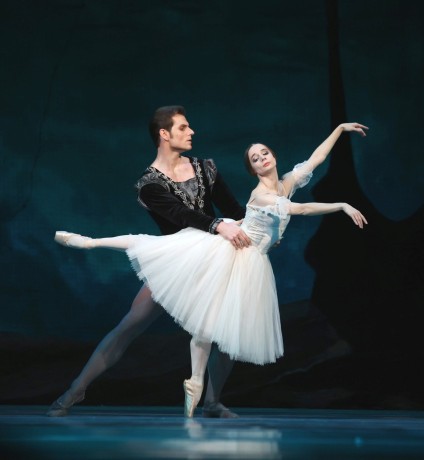Czech cultural magazine and 30th birthday interview
With Michal Krcmar about ballet's life of the Etoile in Finland

Michal Krcmar has drew the attention to himself ten years ago as a significant talent. Already as a student won several awards at international ballet competitions and after graduating from the Prague Conservatory he immediately started to dance solo roles at the Prague State Opera ballet: Prince in Swan Lake, in Cinderella or Albert in Giselle. However, he remained in the company for only a year and joined the Finnish National Ballet as soloist dancer in 2011/2012 season. Nowadays he is Leading Principal dancer of the company and one of our most successful dancers, but the Czech audience has already lost sight of him. Michal Krcmar is at the peak of his career, today he is celebrating his 30th birthday and we took this opportunity to talk about his experiences and plans.
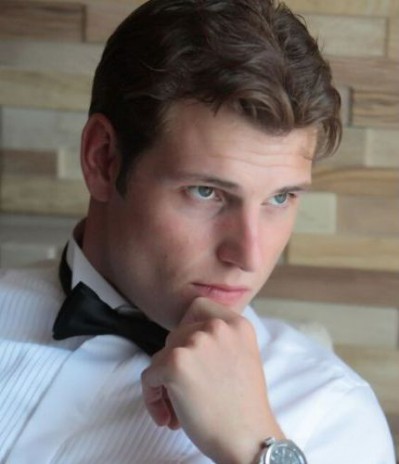
Michal Krcmar (photo: Piero Bonifacio)
Our audience would definitely remember you from the graduation year. Do you also remember the time of your studies and the Bohemia Ballet? Who do you think influenced you the most at school and prepared you for a career of soloist?
Of course, I remember exactly the period that prepared me very well for a career as a professional artist. From the Dance Conservatory of the Capital city of Prague They were mainly: Jurij Slypyč top teacher and friend; Jaroslav Slavický, great persona of Czech classical ballet; and the one who is not with us anymore Miroslav Hajn, great character and damn good man. The first season of my career at Bohemia Ballet gave me incredible experience, the flexibility to deal with anything, with any conditions, and great strength. I remember it perfectly. It was a bold step for all of us who went for it. 2009–2010 was also the first year that Bohemia Ballet became a truly professional company. At that time, I received a few phone calls from the biggest Czech ballet companies, where I was offered a job and some even told me that I was not doing well to start a career in a "school company" and for my future it is literally a step backwards. But the opposite was true. Thanks to Jaroslav Slavický, I danced a lot. I performed on many stages of Czech theaters, flew to dance around the world, attended ballet festivals, I was also able to guest at the Prague State opera ballet, the J. K. Tyl Theater and Ostrava, which was a big step in the first season after school.
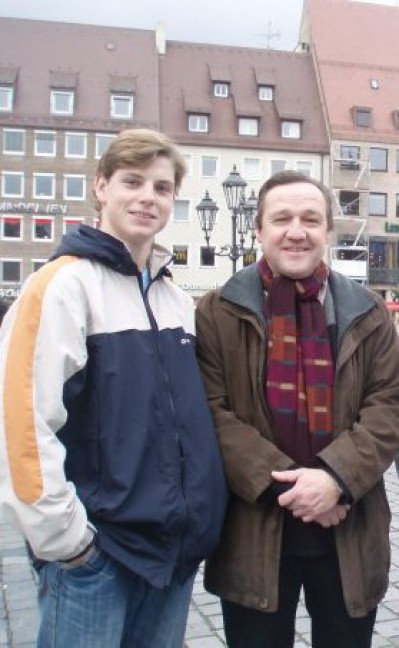
Michal Krcmar and Miroslav Hajn (photo from 2008)
Are you in contact with your classmates, do you know each other how your careers are developing?
Yes we are in touch. We even have our private group on Facebook. We watch each other, who dances what, how we are doing, and also whose families are growing. Four years ago, I even had a chance to meet on the stage with my classmate Nela Mrazova (she is a soloist at Ballett Chemnitz), when Jiří Pokorný invited us both to perform in the leading roles in the ballet Spartacus on a tour with DJKT. (Theater of Josef Kajetan Tyl)
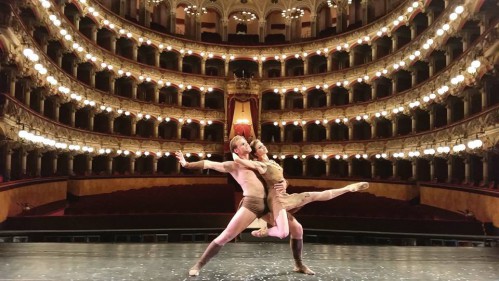
After a short period in the Prague State opera, you moved to Finland. What attracted you to leave to this country? You were starting very promising career at home.
I have always wanted to leave, to open my horizons, to learn languages. Already at school, I admired people who had the courage to leave the Czech Republic and start from scratch abroad, and believe me, it's not easy. Before this big move, I wanted to have more practice. I did not want to come somewhere as a complete greenhorn. Finland was the first option. I grabbed the opportunity and didn't let go. I wasn't very attracted to Finland, and to admit, I didn't know much about Suomi. I just tried the first available option. Later I found out what Finland offers and how everything works. As a soloist dancer at the Prague State Opera, I became involved in the union, trying to fight against ignorance and decisions of the Ministry of Culture and former Minister Besser. I was very young and naive. The last drop towards my departure was, that we could not beat the system that treated and decided about artists absolutely incompetently, so I could try my luck somewhere else. One of the first things in Helsinki was that I joined the union. I wanted to continue to contribute to better conditions and treating people equally.
You are working as guest Principal dancer as well, but you are apparently loyal to your home company. Have you ever wanted to try to work in another place?
I am loyal to the Finnish National Ballet, because of the way how they treat artists in this company. Open space for communication, the possibility of frequent guesting after previous agreement with directory, respect and great conditions for carrying out my job. I had opportunities to work in many countries. At the beginning of this year, I was invited to perform at the Teatro San Carlo in the role of a prince in the ballet Nutcracker (choreographed by the artistic director of The Teatro San Carlo Giuseppe Picone). I have to admit the fact that I liked working in the Neapolitan company.
![]()
Michal Krcmar as Prince in Nutcracker (Teatro San Carlo chor: Giuseppe Picone, photo Francesco Squeglia 2020)
You have already a large number of roles on your account. Many productions of most famous choreographers, recently Vronsky in Ana Karenina by Alexei Ratmansky, you danced in Sylvia by John Neumeier, in Cinderella by David Bintley. What roles influenced you the most?
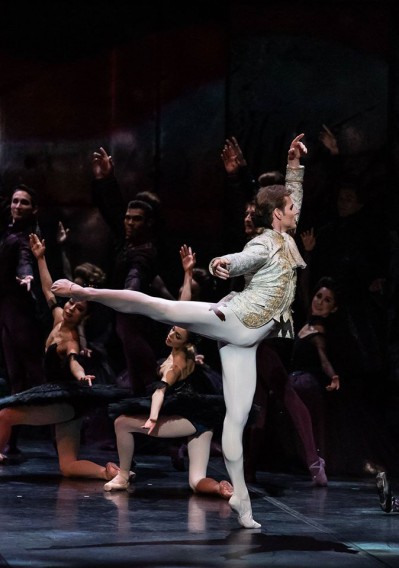
Michal Krcmar as Prince in Cinderella (chor David Bintley FNB 2018, photo Roosa Oksaharju)
One of the first big roles was Romeo in Romeo and Juliet, choreographed by John Cranko, where I felt great emotional "turn" during my premiere. To dancers, actually to all artists, often happens, that they are ready, enthusiastic to enter the stage and they leave it "like a little someone else". These are magical moments that are happening during life performances. Specially when acting is connected with dance and beautiful music. I felt something similar when I was preparing the role of Des Grieux in Manon (chor: Kenneth MacMillan). I really love that role. It is very special. Manon is an amazing ballet and I hope that the Czech audience will have a chance to see it in the choreography of Kenneth MacMillan.
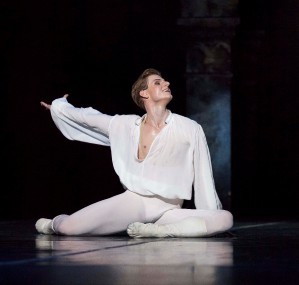
Michal Krcmar as Romeo (Romeo and Juliet, chor John Cranko, FNB 2012, photo Sakari Viika)
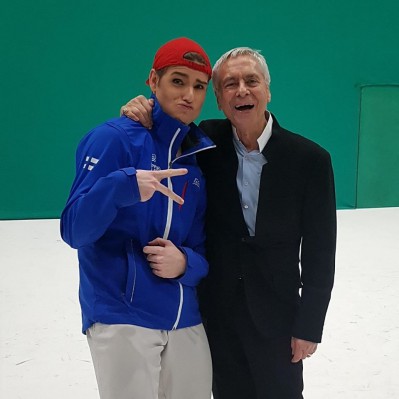
Michal Krcmar and John Neumeier (after premiere of Sylvia in FNB 2019)
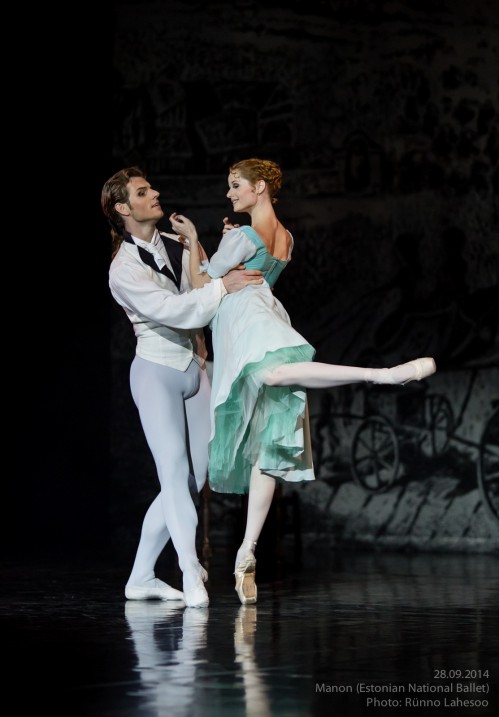
Michal Krcmar and Alena Shkatula in Manon (chor: Kenneth MacMillan, Estonian National Ballet 2014, photo Runno Lahesoo)
Has been any rehearsals extra special for you lately? Experience with some of the choreographers that you would like to share with our audience?
Last spring, I worked with Alexei Ratmansky and I must say that it was something incredible. Very nice and surprising experience. Apart from being a huge professional, great mover, sensitively musical, he treats his dancer who are representing his choreography extraordinarily. He acts with respect and dignity. He's a very nice, humble person, and that's more important to me than working with an arrogant star. Such work fulfills me, satisfies me, BUT SPECIALLY MOTIVATES ME !!!
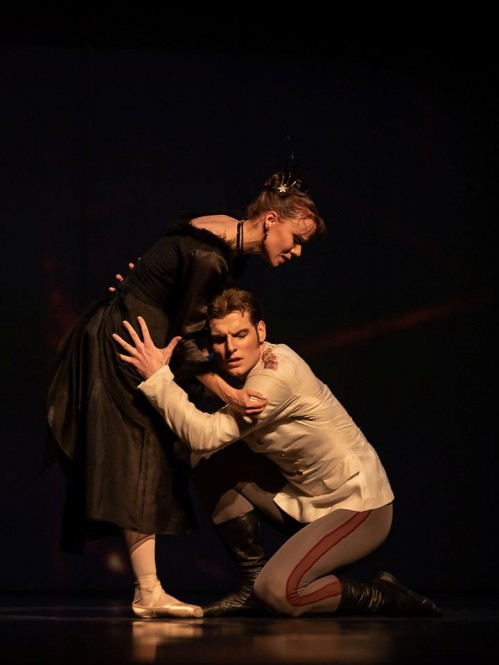
Michal Krcmar and Linda Haakana in Anna Karenina (chor: Alexei Ratmansky, FNB 2019, photo Roosa Oksaharju)
By the way, you met twice Lifar's Suit en Blanc. How's like to dance it as a student, and then after ten years as experienced dancer?
Personally, I am not big fan of Suit en Blanc, and when I've got to know that I should dance it again, I wasn't very excited. From Lifar's Suit en Blan, I enjoy the Mazurka variation. When I danced it at school, I really loved it. Cyril Atanassoff, the huge star of the Paris Opera, worked with us during that time and it was an invaluable experience. Mainly because he was very friendly and supportive. I don't even have to mention that he was a great coach and teacher. It is very often connected and it is like this: The biggest and most professional stars are great and humble people and they don't have to prove anything. They don't put the dancers' self-confidence down for increasing their already huge ego.
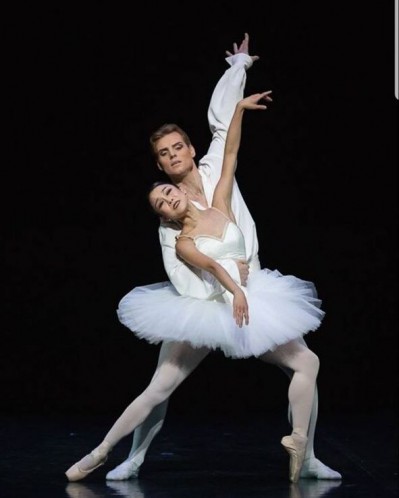
Michal Krcmar and EunJi Ha in Suit en Blanc (chor: S. Lifar, FNB 2018, photo Mirka Kleemola)
You are, of course, given as an example of a successful student of our dance education. Do you remember the years you spent at the dance academy, how do you evaluate them retrospectively? Is there anything that bothers you, that you would change at the system?
I remember many good things. I'm also glad I'm done with it. I believe that if you motivate and take time to be interested in a student, he will perform even better than if you scream at him all day long. This is case by case of course. Some students want to collaborate and learn something. But what about those who do not want…? This brings questions: Do we have time for an individual approach? Find out why or what is the student's problem? There is a lot to consider and even more that precedes it. The conservatory is primarily a selective school. The moment the student is accepted, he is selected by experts who believe in his potential. The conservatory is not an elementary school and students often give it up because they cannot take a very demanding time schedule and physical pressure. Understanding on both sides, both from the teachers and the students, is important, specially in schools like conservatory. Both sides should be a little bit closer. Perceive each other. I met mostly very understanding teachers who wanted to help. My opinion is that parents should "pull the rope" same direction with teachers. Communicate with them and trust each other. It's easy to tell, but as I am saying: It's case by case, every student is different and special with different problems, needs, background, families and needs.
One of your favorite roles is Solor in La Bayadere, choreographed by Natalia Makarova. Premiered in 1980. Why is it still so popular? What is the magic of this production?
Where to start… Precision, musicality, simplicity, costumes, directing… In Makarova's production, everything worked out as it should. Thanks to the great team of people as well. It's the most beautiful version ever and will be for a long time. I don't think there's much to explain, everyone who is interested in ballet knows what I'm talking about. This version dances and acts it's self. What to add... It is really a beauty, a jewel and a treasure in the repertoire of each ensemble, which is lucky enough to dance La Bayadere choreographed by Natalia Makarova. Solor is a very special to me, I always enjoy to performing him.
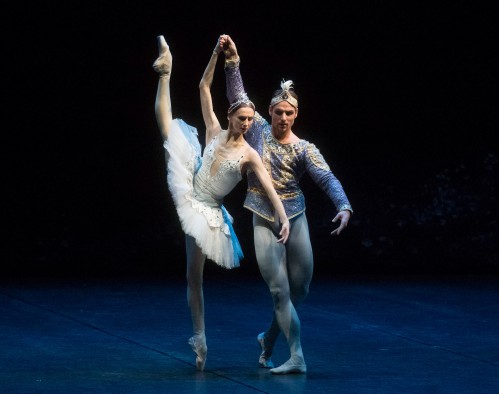
Michal Krcmar and Svetlana Zakharova in La Bayadere (chor, Natalia Makarova, FNB 2016, photo Mirka Kleemola)
What do you think about Bayadere by Javier Torres, in which you even danced as guest in Czech National ballet? Did you meet his other ballets, how did you work with him?
For me, Javier is a very capable director of productions who has interesting ideas. I worked with him mainly on the brand new ballet The Beauty and The Beast, which we, prepared together with ballet mistress Ingrid Němečková and dance partner Edita Raušerová, in Prague during Summer 2013. The full-length ballet had premiere in February 2014 in Helsinki. It was a decent success. The work was interesting, but sometimes choreographically very complicated, often ineffective for the audience's eye. It cost you a tremendous effort to perform all the steps precisely and into the music, but the result was a bit lost in the huge number of overstepped elements.
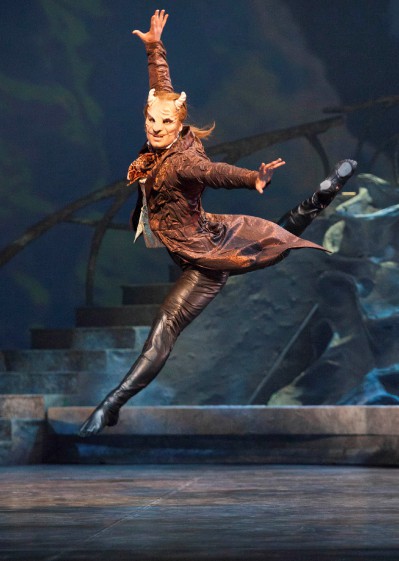
Michal Krcmar as Beast in The Beauty and The Beast (chor: Javier Torres, FNB 2014, photo Mirka Kleemola)
You also danced Cranko's Onegin, which the Czech National ballet has on the repertoire as well. That role offers a huge range in the individual conception, from cruel and heartless man to the character of a rather clueless and vulnerable. What do you think of your Onegin? And does Cranko's concept correspond to the book's prototype of the hero?
I danced Onegin several times over the years and each time differently. This role is very much related to the age and experience of the artist. I first appeared as Onegin when I was 24 years old. Even then, I realized what it meant. To create man in different situations and stages of life. I could really talk for hours about Onegin and my experience with this character, but the readers are probably not curious about it… I read Pushkin, but I certainly don't see Onegin as a "hero" for myself. For me, he is an arrogant nobleman. He has very good manners. He is a clever, player, foolish, playboy, spoiled by lifestyle. He does not know what is really important and beautiful in life. When he finds out, it's too late for almost everyone close to him… That's just my very, very, very brief look to Cranko's Onegin...
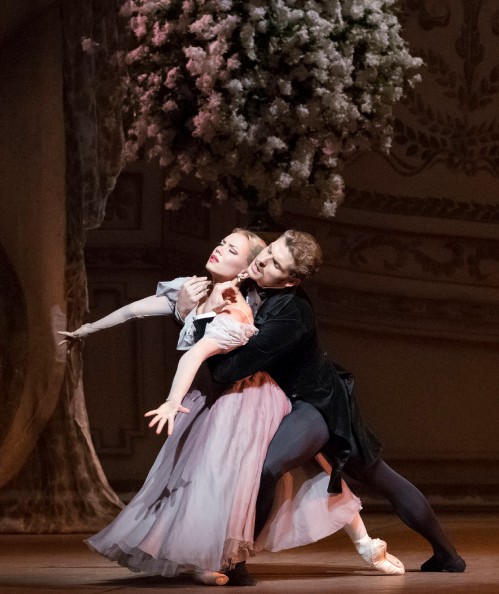
Michal Krcmar and Salla Eerola in Onegin (chor: John Cranko, FNB 2015, photo Mirka Kleemola)
Not only Onegin, but also Romeo and Juliet, Manon, Anna Karenina, The Lady of the Camellias, many ballets have their literary models. Do you read them while studying the roles to find inspiration for your characters, or do you let the director's intentions guide you?
Of course, I read everything what I need before preparing the role. I watch movies and put a large part of myself into a newly creating characters. Some characters are easier to find and perform. Others need more time to find right way to dance. Every role I've ever danced and had a chance to return to after years, I dance differently every time. Every performance I dance differently. That is the beauty of our job. I enjoy it very much. It's nice a "competition" with myself. With my younger "me". I'm thirty years old today and I can't wait for any of the role to come back to me. I'll have a chance to clean it again and probably completely remake, what I've once already finished.
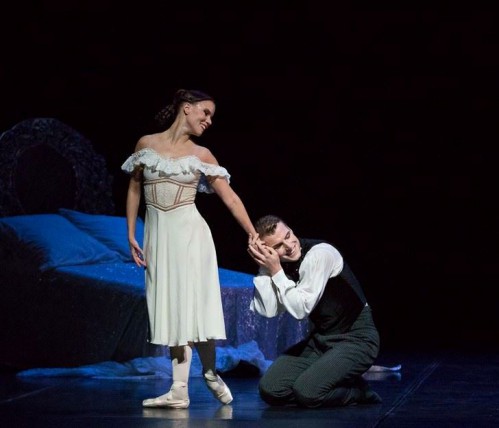
Michal Krcmar and Linda Haakana in Lady of the Camellias (chor: Val Caniparoli, FNB 2017, photo Mirka Kleemola)
Your wife is also ballet dancer. Don't you combine work and privacy in one? What is your recipe for "being sick of ballet" at home?
I've never felt it, on the contrary, I can't imagine being with someone who doesn't understand ballet. Or who hasn't experienced what it means to be a professional ballet dancer. The recipe is that we don't talk much about work. Life is too short for that.
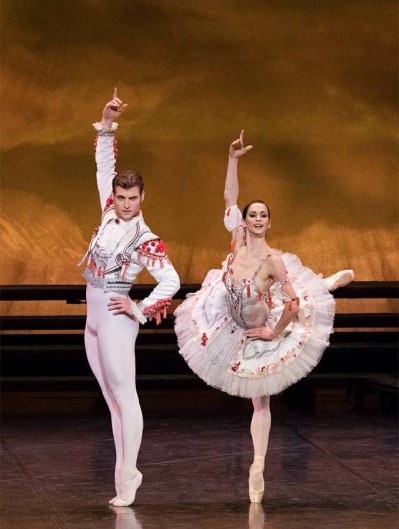
Michal Krcmar and Polina Semionova in Don Quijote (chor: Patrice Bart, FNB 2018, photo Mirka Kleemola)
How different is the life of a dancer in Finland compared to Czech Republic? Do you have good salary conditions? What about injury prevention, rehabilitation, service of this kind at the theater?
We can't complain. Finland is a very expensive country, but salaries are higher as well. Finland has better conditions meaning salary/prices, everyone knows that. In the theater we have a great background, physiotherapy and a doctor's consulting room. Rehabilitation is solved by everyone's needs. Someone is attending private physiotherapy or a doctor. It's very similar in all ballet companies.
Is the "second career" of dance artists being subject of debating? You are still very young and in top of your strength, so it doesn't concern you yet, but…
In Finland, there is a dance pension, which dancers get at the age of forty-four. I haven't worked on my second career yet. I do imagine even leave ballet completely and move to South after many years of cold Finland. Find an absolutely normal job and enjoy normal life. Occasionally teach at ballet schools which I have been doing during some time off, for the last few years. So far, I'm leaving this door to another career open.
I can't help but ask how did you spend your time in quarantine? How did Finland cope with the crisis, what measures affected you and dancers?
I think we are all tired of this topic. Unfortunately, it is still relevant, but it is important not to live in fear. The media often manipulate the human mind in unexpected ways. Taking everything with healthy reserves, caution,following the instinct and common sense can save more lives than measures that are in some cases exaggerated.
We were at home in Helsinki, like almost everyone around the world. Voluntary classes, online meetings were organized and further government orders were awaited. I think that Finland has managed the crisis well, but time will tell.
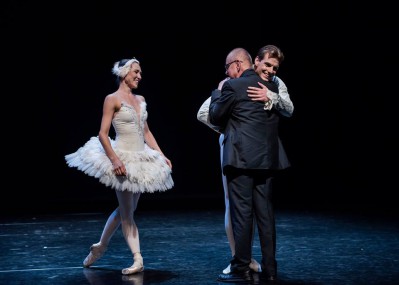
Michal Krcmar and Nikola Marova in Honor to Jaroslav Slavicky (Nova Scena 2018, photo Serghei Gherciu)
Is it worse for you to not be able to train and perform, or the lack of contact with the company? Dancers are exceptionally sociable "creatures" Used to constant physical closeness and the touch of others…
I miss the stage the most. I hate ballet studios, in the ballet studio I always feel like a visiting guest and on stage feels like I'm finally home. Thanks to the quarantine, I had the opportunity to spend a lot of time with our ten months old daughter, so it turned out well for us. In the spring I had a lot of plans, traveling and performing in Kazakhstan, London, Riga, Milan and Magdeburg. But thanks to quarantine I had time for what's really important.
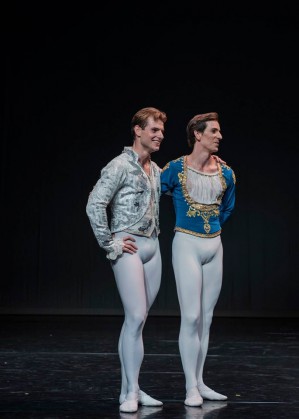
Michal Krcmar and Adam Zvonar in Honor to Jaroslav Slavicky (classmates from academy, Nova Scena 2018, photo Serghei Gherciu)
A lot has started. Many companies have decided to publish records of their productions. Didn't you discover any treasures on the internet as a spectator? How did you train?
I have to admit that I did not look for anything. During the quarantine, I absolutely switched off and lived mainly as a husband and dad. I didn't train ballet at all. I prefer other methods because I do ballet at work during the seasons.
.
Do you have Czech or Finnish citizenship?
I have Czech citizenship. I don't even plan to do Finnish and thanks to the EU I don't even need to.
Is it important for you to know where your origins are? National songs, the history of the nation, Czech as the language of novels and poems… Will you pass on some of this heritage to your daughter? For example, I can't imagine live abroad, not showing to my children the beauty of the verses Sládek or Nezvala, or they wouldn't know Mánes, Kosárek, Mařák. At the same time, I know that a dual identity would confuse them. Do you think that you will not have such a dilemma?
I speak to my daughter Czech every day, my wife Italian. We have also been slowly learning each other's language for last four years and making good progress. I teach little Sofia Czech language so in the future she can learn something about her father's culture if she would be interested. Our daughter is a child of Europe. Born in Finland, with background from Italy and Czechia. My wife and I will raise her to have an open mind to all cultures. Each has a lot of beautiful things to offer. We will certainly not impose or prioritize any of them. When the time comes, she will choose her own path and follow what she desires.
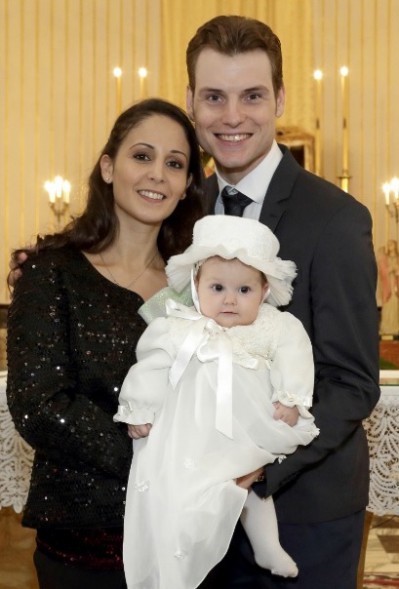
Stefania Cardaci-Krcmar, Sofia Krcmar and Michal Krcmar (photo Pietro Bonifacio)
Occasionally you do your own choregraphies. Do you currently have inspiration for any new ones? Do you see it as a possibility of future realization once you stop dancing?
I really enjoy making choreographies. Unfortunately I'm fully busy being the Principal dancer at FNB and elsewhere. I would definitely not resist to make choreographies. I have a lot of ideas. I enjoy directing, which is very important to me.
So far, you definitely have a long career ahead of you. What roles and choreography are coming to you in the upcoming season?
If everything stays as planned at the moment, Konrad in the ballet Le Corsaire, perhaps the most famous version choreographed by Anna-Marie Holmes, is waiting for me first. Then a completely new feature ballet and an interesting project Mr. Jekyll and Mr. Hyde, on which I started working in the spring as Mr Hyde (directed and choreographed by Val Caniparoli), another world premiere of the ballet Swan Lake by former Australian ballet director David McAllister. I am also negotiating guesting in very interesting places in amazing productions, but I will keep the details to myself for now.
Thank you very much for your time Lucie. I say goodbye to the Czech audience for this moment and I hope that I will soon have the opportunity to return and perform at home again. I wish everyone a pleasant summer full of peace, rest, health and love. The other things are not important. Sincerely, Michal Krcmar
You can follow the work of Michal Krcmar on the website
www.michal-krcmar.cz
and on social networks:
Instagram:
http://https://www.instagram.com/michalkrcmarofficial/
Facebook:
http://https://www.facebook.com/MichalKrcmarCZ/
YouTube:
https://www.youtube.com/user/MichalKrcmar
The editors of Opera PLUS wish to Michal Krcmar good health and many beautiful new roles in his next career!


